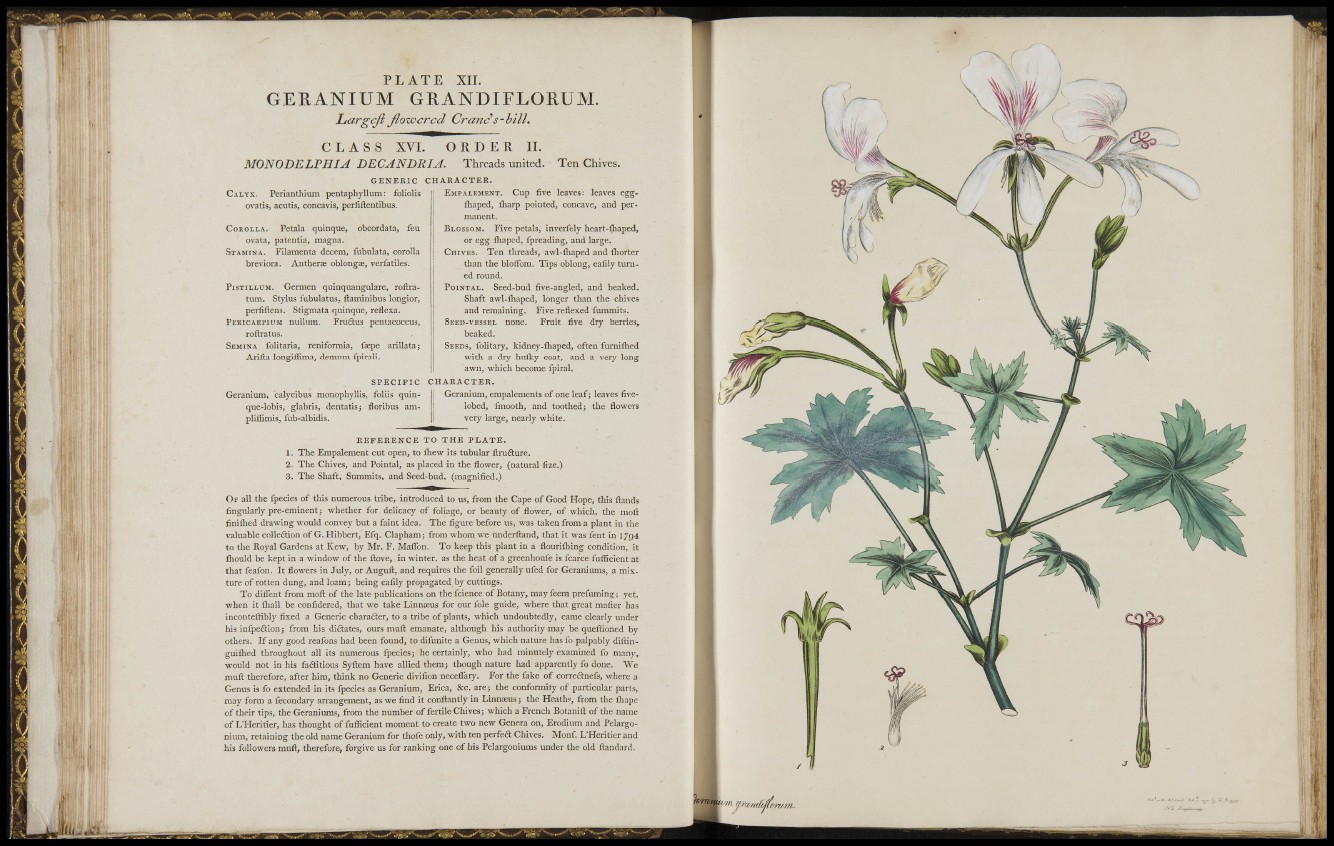
P L A T E XII.
GERANIUM GRANDIFLORUM.
hargeji flowered Crane s-hill.
C L A S S XVL ORDER IL
MONODELPHIJ DECJNDRIJ. Threads united. Ten Chives.
G E N E R I C
CALVX. Perianthium pentaphyllum: foliolis
ovatis, acutis, concavis, perfiftentibus.
COROLLA. Pétala quinqué, obcordata, feu
ovata, patentia, magna.
STAMINA. Filamenta decern, fubulata, corolla
breviora. Antherae oblongas, verfatiles.
PisTiLLUM. Germen quinquaiigulare, roftratum.
Stylus fubulatus, ftaminibus longior,
perfiftens. Stigmata quinqué, reflexa.
P E K I C A R P I UM nullum. Fruñus pentacoccus,
roftratus.
SEMINA lolitaria, reniformia, fsepe arillataj
Arifta longiflima, demum fpirali.
S P E C I F I C
Geranium, calycibus monophyllis, foliis quinque
lobis, glabris, dentatis; floribus ampliffimis,
£ub-albidis.
C H A R A C T E R .
EMPALEMENT. Cup five leaves: leaves egglliaped,
fliarp pointed, concave, and permanent.
BLOSSOM. Five petals, inverfely heart-iliaped,
or egg ihaped, ipreading, and large.
CHIVES. Ten threads, awl-ihaped and fliorter
than the bloffom. Tips oblong, eafily turned
round.
PoiNTAL. Seed-bud five-angled, and beaked.
Shaft awl-fliaped, longer than the chives
and remaining. Five reflexed fummits.
SEED-VESSEL none. Fruit five dry berries,
beaked.
SEEDS, folitary, kidney-fliaped, often furniflied
with a dry huiky coat, and a very long
awn, which become fpiral.
C H A R A C T E R .
Geranium, empalements of one leaf; leaves fivelobed,
fmooth, and toothed; the flowers
very large, nearly white.
R E F E R E N C E TO THE PLATE.
1. The Empalement cut open, to ihew its tubular ftrufture.
2. The Chives, and Pointal, as placed in the flower, (natural fize.)
3. The Shaft, Summits, and Seed-bud, (magnified.)
OF all the fpecies of this numerous tribe, introduced to us, from tlie Cape of Good Hope, this ilands
fingvJarly pre-eminent; whether for delicacy of foliage, or beauty of flower, of which, the moll
finiflied drawing would convey but a faint idea. The figure before us, was taken from a plant in the
valuable colleftion of G. Hibbert, Efq. Clapham; from whom we underftand, that it was fent in 17g4
to the Royal Gardens at Kew, by Mr. F. Maflbn. To keep this plant in a flourifhing condition, it
ihould be kept in a window of the ftove, in winter, as the heat of a greenhoufe is fcarce fufficient at
that feafon. It flowers in July, or Augull, and requires the foil generally ufed for Geraniums, a mixture
of rotten dung, and loam; being eafily propagated by cuttings.
To diffent from mofl: of the late publications on thefcience of Botany, may feem prefuming; yet,
when it fliall be confidered, that we take Linnaeus for our fole guide, where that great mafter has
inconteftibly fixed a Generic character, to a tribe of plants, which undoubtedly, came clearly under
his iufpefiion; from his dictates, ours muft emanate, although his authority may be queftioned by
others. If any good reafons had been found, to difunite a Genus, which nature has fo palpably diftinguifhed
throughout all its numerous fpecies; he certainly, who had minutely examined fo many,
would not in his faftitious Syftem have allied them; though nature had apparently fo done. We
muit therefore, after him, think no Generic divifion neceflary. For the fake of correftnefs, where a
Genus is fo extended in its fpecies as Geranium, Erica, &c. are; the conformity of particular parts,
may form a fecondary arrangement, as we find it conftantly in Linnaeus; the Heath«, from the lhape
of their tips, the Geraniums, from the number of fertile Chives; which a Frencli Botanift of the name
of L'Heritier, has thought of fufficient moment to create two new Genera on, Erodium and Pelargonium,
retaining the old name Geranium for thofe only, with ten perfeft Chives. Monf. L'Heritier and
his followers muft, therefore, forgive us for ranking one of his Pelargoniums under the old ftandard.